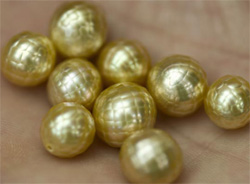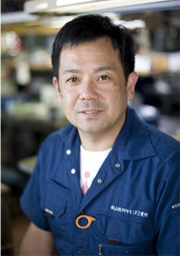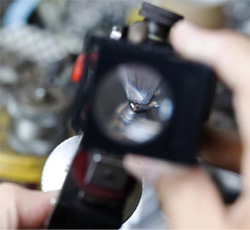Home > Highlighting JAPAN > Highlighting Japan NOVEMBER 2012 > Pearls with an Edge
Highlighting JAPAN
[SERIES] JAPAN BRAND
Pearls with an Edge
Komatsu Cutting Factory & Diamond Industry has changed the landscape of the world's jewelry market with its development of faceted pearls. Gavin Blair reports.

Gold faceted pearls processed by Komatsu Cutting Factory and Diamond Industry
Credit: ROB GILHOOLY
The company's founder came up with the idea of cutting pearls when its business supplying diamonds to one of Japan's major electronics manufacturers went into decline in the 1990s.
The novelty of cut pearls attracted much interest when they were first exhibited at the International Jewellery Tokyo trade fair in 1995, explains Kazuhito Komatsu, the founder's son, who now runs the company. The company had to send for more samples as its booth at the fair was swamped by curious buyers. However, turning this interest into a sustainable business proved more challenging, at least at first.
"Many people asked us, 'Why would you want to cut something as naturally beautiful as pearls?' It was actually a buyer from the United States who, shortly afterward, was first really interested in selling our faceted pearls," recalls Komatsu.

Kazuhito Komatsu, president of Komatsu Cutting Factory and Diamond Industry
Credit: ROB GILHOOLY
The idea behind faceted pearls, or hana shinju (gorgeous pearls), is to enhance their natural properties, using only the original colors, explains Komatsu.
A Pearl of an Idea
The company was formed in the late 1960s when Komatsu senior, who had worked at a nearby diamond-cutting factory, decided to utilize the traditional artisanship of the Kofu area, which has a long history in jewelry-making. Komatsu got its start in business when the finance ministry sold the stock of diamonds left over from the jewelry that Japanese people had handed over to the government to help the war effort. Diamonds had continued to be the mainstay of the company's business until the pearl cutting techniques were developed.
"Pearls now make up 90 to 95 percent of our business," says Komatsu.
The largest part of Komatsu's business is now made up of cutting pearls that are sent to the company from around Japan and the world, with income from overseas set to top 40 percent of revenue this year for the first time. Komatsu admits that he and his craftsmen are now so busy with this side of the business that they barely have time to work on their own designs these days.

Kazuhito Komatsu looks through a loupe at a gem that is just a few mm in size to check the cuts he has made.
Credit: ROB GILHOOLY
As a huge soccer fan, I found the Soccer Pearl a novel and irreverent take on traditional pearl jewelry and was disappointed there wasn't one in the colors of my local J-League team; had there been, I'm not sure I could have resisted the temptation to buy one.
Komatsu's seminal "double refraction cut" won a Gemmy award in the United States in 2009, and a Prime Minister's Prize in Japan's Monodzukuri Nippon Grand Awards for application of traditional techniques in the same year.
Faceted pearls are now being sold in Asia, Europe and the United States, with the gold-colored pearls being particularly popular in China, Hong Kong and Taiwan, according to Komatsu.
Still in his late thirties, Komatsu says he feels privileged to be able to meet and learn about people from around the globe, thanks to the techniques developed by his father, and the worldwide business he has grown them into.
© 2009 Cabinet Office, Government of Japan






